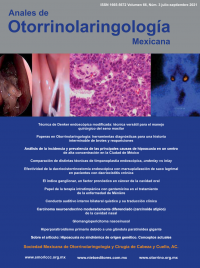
Analysis of the incidence and prevalence of the main causes of hearing loss in a high-concentration center in Mexico City.
An Orl Mex. 2021; 66 (3): 192-199. https://doi.org/10.24245/aorl.v66i3.5453
María de Lourdes Colón-Martínez,1 Nieves del Rosario Ocaña-Planté,1 Emilio Arch-Tirado,3 Ana Luisa Lino-González2
1 Subdirección de Audiología, Foniatría y Patología del Lenguaje, Servicio de Audiología y Otonoeurología.
2 Subdirección de Investigación Clínica, División de Neurociencia, Área de Neurociencia Clínica.
Instituto Nacional de Rehabilitación Luis Guillermo Ibarra Ibarra, Ciudad de México, México.
3 Centro Neurológico del Centro Médico ABC, sede Santa Fe, Ciudad de México, México.
Resumen
ANTECEDENTES: En 2018 se reportó un aproximado de 466 millones de personas con algún grado de pérdida auditiva considerada discapacitante.
OBJETIVO: Analizar la incidencia y prevalencia de las principales causas de hipoacusia en un centro de alta concentración en la Ciudad de México.
MATERIALES Y MÉTODOS: Estudio retrospectivo y descriptivo efectuado en el periodo 2015-2019 en el Instituto Nacional de Rehabilitación Luis Guillermo Ibarra Ibarra, Ciudad de México. Se analizó información proveniente de la base de datos institucional del Servició de Audiología y Otoneurología y se estudiaron las variables edad, sexo y causa de hipoacusia. Se realizó un análisis descriptivo inicial, se calcularon intervalos de confianza para la media y para la proporción con α = 0.05.
RESULTADOS: La categoría de causa más frecuente de hipoacusia fue la multicausal seguida de la degenerativa, el intervalo de confianza que representó a los pacientes con mayor edad fue el obtenido para hipoacusia degenerativa, asimismo, el intervalo de confianza para la proporción que mostró el mayor porcentaje de pacientes fue el de hipoacusia multicausal. La probabilidad de que llegue al hospital un paciente con hipoacusia, que ésta sea de origen multicausal y el paciente sea mujer fue del 30.8%.
CONCLUSIONES: La proporción de hipoacusia degenerativa es relevante porque se espera que sea mayor en los próximos años debido a la inversión de la pirámide poblacional y la transición demográfica.
PALABRAS CLAVE: Hipoacusia; incidencia; prevalencia.
Abstract
BACKGROUND: In 2018, about 466 million people were reported with some degree of hearing loss considered disabling.
OBJECTIVE: To analyze the incidence and prevalence of the main causes of hearing loss in a high-concentration center in Mexico City.
MATERIALS AND METHODS: A retrospective, descriptive study covering the period 2015-2019 at National Institute of Rehabilitation Luis Guillermo Ibarra Ibarra, Mexico City was done. Information from the institutional database of the Audiology and Otoneurology Service was analyzed and the variables age, sex and cause of hearing loss were studied. An initial descriptive analysis was performed, confidence intervals were calculated for the mean and for the proportion with α = 0.05.
RESULTS: The most frequent category of cause of hearing loss was multicausal followed by degenerative, the confidence interval that represented older patients was that obtained for degenerative hearing loss, likewise, the confidence interval for the proportion that showed the highest percentage of patients was multicausal hearing loss. The probability that a patient with hearing loss arrive to the hospital, that it was of multicausal origin and that the patient was a woman was 30.87%.
CONCLUSIONS: The proportion of degenerative hearing loss is relevant since its presence is expected to be greater in the coming years due to the inversion of the population pyramid and the demographic transition.
KEYWORDS: Hearing loss; Incidence; Prevalence.
Recibido: 5 de marzo 2021
Aceptado: 22 de junio 2021
Este artículo debe citarse como: Colón-Martínez ML, Ocaña-Planté NR, Arch-Tirado E, Lino-González AL. Análisis de la incidencia y prevalencia de las principales causas de hipoacusia en un centro de alta concentración en la Ciudad de México. An Orl Mex. 2021; 66 (3): 192-199.

